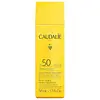What's inside
What's inside
 Key Ingredients
Key Ingredients

 Benefits
Benefits

 Concerns
Concerns

 Ingredients Side-by-side
Ingredients Side-by-side

Water
Skin ConditioningOctocrylene
UV AbsorberEthylhexyl Salicylate
UV AbsorberPropanediol
SolventButyl Methoxydibenzoylmethane
UV AbsorberPolymethyl Methacrylate
Dimethicone
EmollientPhenylbenzimidazole Sulfonic Acid
UV AbsorberPolysilicone-15
UV FilterPropylene Glycol Dicaprylate/Dicaprate
EmollientTromethamine
BufferingBis-Ethylhexyloxyphenol Methoxyphenyl Triazine
Skin ConditioningSilica
AbrasiveDimethicone/Vinyl Dimethicone Crosspolymer
Skin Conditioning1,2-Hexanediol
Skin ConditioningPolysorbate 60
EmulsifyingPEG-10 Dimethicone
Skin ConditioningSodium Hyaluronate
HumectantTocopheryl Acetate
AntioxidantXanthan Gum
EmulsifyingCaprylyl Glycol
EmollientParfum
MaskingDisodium EDTA
PEG-8
HumectantTocopherol
AntioxidantTropolone
Skin ConditioningAscorbyl Palmitate
AntioxidantAscorbic Acid
AntioxidantCitric Acid
BufferingWater, Octocrylene, Ethylhexyl Salicylate, Propanediol, Butyl Methoxydibenzoylmethane, Polymethyl Methacrylate, Dimethicone, Phenylbenzimidazole Sulfonic Acid, Polysilicone-15, Propylene Glycol Dicaprylate/Dicaprate, Tromethamine, Bis-Ethylhexyloxyphenol Methoxyphenyl Triazine, Silica, Dimethicone/Vinyl Dimethicone Crosspolymer, 1,2-Hexanediol, Polysorbate 60, PEG-10 Dimethicone, Sodium Hyaluronate, Tocopheryl Acetate, Xanthan Gum, Caprylyl Glycol, Parfum, Disodium EDTA, PEG-8, Tocopherol, Tropolone, Ascorbyl Palmitate, Ascorbic Acid, Citric Acid
Zinc Oxide 21.1%
Cosmetic ColorantWater
Skin ConditioningCaprylic/Capric Triglyceride
MaskingButyloctyl Salicylate
Skin ConditioningCalcium Sodium Borosilicate
Erythritol
HumectantLauryl Laurate
Skin ConditioningPropanediol
SolventCarthamus Tinctorius Oleosomes
EmollientBentonite
AbsorbentNiacinamide
SmoothingPalmitoyl Grapevine Shoot Extract
AntioxidantCetearyl Alcohol
EmollientCaprylyl Glycol
EmollientEthyl Ferulate
AntioxidantSucrose Polystearate
EmollientHelianthus Annuus Seed Oil
EmollientSucrose Stearate
EmollientCoco-Glucoside
CleansingBisabolol
MaskingCitric Acid
BufferingCaramel
Cosmetic ColorantPolyhydroxystearic Acid
EmulsifyingPongamia Pinnata Seed Extract
Skin ConditioningSodium Gluconate
Skin ConditioningCaprylhydroxamic Acid
Glycerin
HumectantTocopherol
AntioxidantMicrocrystalline Cellulose
AbsorbentBeta-Sitosterol
Emulsion StabilisingGluconolactone
Skin ConditioningSqualene
EmollientXanthan Gum
EmulsifyingAloe Barbadensis Leaf Juice Powder
Skin ConditioningSodium Benzoate
MaskingZinc Oxide 21.1%, Water, Caprylic/Capric Triglyceride, Butyloctyl Salicylate, Calcium Sodium Borosilicate, Erythritol, Lauryl Laurate, Propanediol, Carthamus Tinctorius Oleosomes, Bentonite, Niacinamide, Palmitoyl Grapevine Shoot Extract, Cetearyl Alcohol, Caprylyl Glycol, Ethyl Ferulate, Sucrose Polystearate, Helianthus Annuus Seed Oil, Sucrose Stearate, Coco-Glucoside, Bisabolol, Citric Acid, Caramel, Polyhydroxystearic Acid, Pongamia Pinnata Seed Extract, Sodium Gluconate, Caprylhydroxamic Acid, Glycerin, Tocopherol, Microcrystalline Cellulose, Beta-Sitosterol, Gluconolactone, Squalene, Xanthan Gum, Aloe Barbadensis Leaf Juice Powder, Sodium Benzoate
 Reviews
Reviews

Ingredients Explained
These ingredients are found in both products.
Ingredients higher up in an ingredient list are typically present in a larger amount.
Caprylyl Glycol is a humectant and emollient, meaning it attracts and preserves moisture.
It is a common ingredient in many products, especially those designed to hydrate skin. The primary benefits are retaining moisture, skin softening, and promoting a healthy skin barrier.
Though Caprylyl Glycol is an alcohol derived from fatty acids, it is not the kind that can dry out skin.
This ingredient is also used as a preservative to extend the life of products. It has slight antimicrobial properties.
Learn more about Caprylyl GlycolCitric Acid is an alpha hydroxy acid (AHA) naturally found in citrus fruits like oranges, lemons, and limes.
Like other AHAs, citric acid can exfoliate skin by breaking down the bonds that hold dead skin cells together. This helps reveal smoother and brighter skin underneath.
However, this exfoliating effect only happens at high concentrations (20%) which can be hard to find in cosmetic products.
Due to this, citric acid is usually included in small amounts as a pH adjuster. This helps keep products slightly more acidic and compatible with skin's natural pH.
In skincare formulas, citric acid can:
While it can provide some skin benefits, research shows lactic acid and glycolic acid are generally more effective and less irritating exfoliants.
Most citric acid used in skincare today is made by fermenting sugars (usually from molasses). This synthetic version is identical to the natural citrus form but easier to stabilize and use in formulations.
Read more about some other popular AHA's here:
Learn more about Citric AcidPropanediol is an all-star ingredient. It softens, hydrates, and smooths the skin.
It’s often used to:
Propanediol is not likely to cause sensitivity and considered safe to use. It is derived from corn or petroleum with a clear color and no scent.
Learn more about PropanediolTocopherol (also known as Vitamin E) is a common antioxidant used to help protect the skin from free-radicals and strengthen the skin barrier. It's also fat soluble - this means our skin is great at absorbing it.
Vitamin E also helps keep your natural skin lipids healthy. Your lipid skin barrier naturally consists of lipids, ceramides, and fatty acids. Vitamin E offers extra protection for your skin’s lipid barrier, keeping your skin healthy and nourished.
Another benefit is a bit of UV protection. Vitamin E helps reduce the damage caused by UVB rays. (It should not replace your sunscreen). Combining it with Vitamin C can decrease sunburned cells and hyperpigmentation after UV exposure.
You might have noticed Vitamin E + C often paired together. This is because it is great at stabilizing Vitamin C. Using the two together helps increase the effectiveness of both ingredients.
There are often claims that Vitamin E can reduce/prevent scarring, but these claims haven't been confirmed by scientific research.
Learn more about TocopherolWater. It's the most common cosmetic ingredient of all. You'll usually see it at the top of ingredient lists, meaning that it makes up the largest part of the product.
So why is it so popular? Water most often acts as a solvent - this means that it helps dissolve other ingredients into the formulation.
You'll also recognize water as that liquid we all need to stay alive. If you see this, drink a glass of water. Stay hydrated!
Learn more about WaterXanthan gum is used as a stabilizer and thickener within cosmetic products. It helps give products a sticky, thick feeling - preventing them from being too runny.
On the technical side of things, xanthan gum is a polysaccharide - a combination consisting of multiple sugar molecules bonded together.
Xanthan gum is a pretty common and great ingredient. It is a natural, non-toxic, non-irritating ingredient that is also commonly used in food products.
Learn more about Xanthan Gum